Monitor "MAPS" parameter on the scantool.
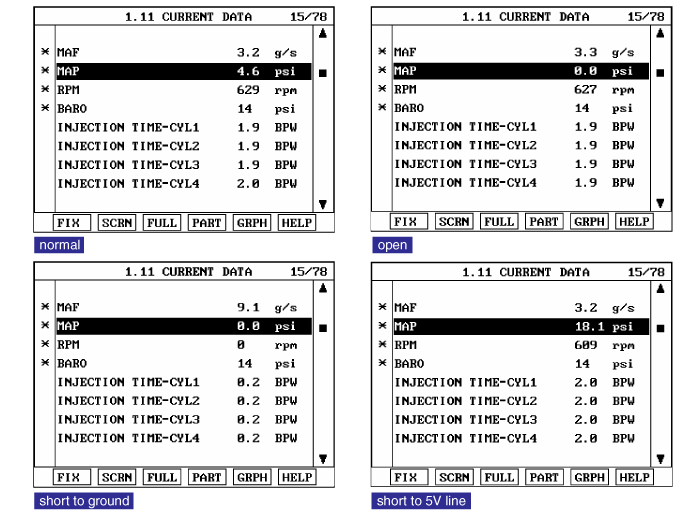
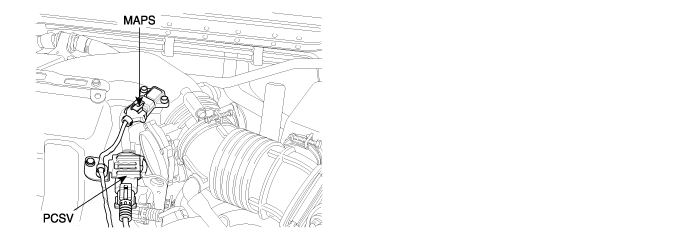
The amount of intake air flow must be inputted to PCM in order to determine the fuel injection quantity. MAPS(Manifold Absolute Pressure Sensor) calculates the amount of air indirectly as measuring the pressure inside of intake manifold. This mechanism is also called Speed-Density Type.MAPS transfers analog output signal which is proportional to the change of intake manifold pressure, then, with this signal and RPM, PCM calculates the amount of intake air flow. MAPS is mounted on surge tank to measure the pressure inside of intake manifold, and it consists of a piezo electric element and hybrid IC which amplifies output signal from the element. A piezo electric element is a sort of a diaphragm using piezo electric effect. One side of the diaphragm is surrounded with vacuum chamber while intake pressure is applied to the other side. Thus, signals are outputted by the transformation of diagphragm according to the change of pressure inside of intake manifold.
Checking output signals of MAPS every 5 sec. under detecting condition, if an output signal is below 0.25V for more than 2.5 sec., PCM sets P0107. MIL(Malfuction Indication Lamp) turns on when the malfunction lasts till continuous 2 driving cycle.
Item | Detecting Condition | Possible cause | |
DTC Strategy | ● This code detects a continuous short to low or open in either the signal circuit or the MAP | ● Connecting condition ● Open or short to ground in power circuit ● Open or short to ground in signal circuit ● MAPS ● PCM | |
Enable Conditions | Case 1 | ● No TPS Active Fault Present ● Ignition Voltage ≥ 11V ● Engine Speed ≤ 1000rpm ● Throttle Position ≥ 0% | |
Case 2 | ● No TPS Active Fault Present ● Ignition Voltage ≥ 11V ● Engine Speed 〉1000rpm ● Throttle Position ≥ 30% | ||
Threshold value | ● MAP Signal 〈 0.25V | ||
Diagnosis Time | ● Continuous (More than 2.5 seconds failure for every 5 seconds test ) | ||
MIL On Condition | ● 2 Driving Cycle | ||
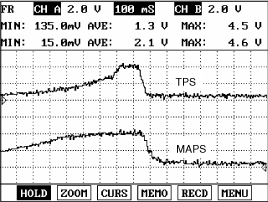
Comparing MAPS and TPS, The signals of MAPS and TPS increasess and decrease simultaneously.
Pressure (kPa) | 20 | 35 | 60 | 95 | 101.32 | ||
Voltage (V) | 0.789 | 1.382 | 2.369 | 3.75 | 4 | ||
Tolerance (V) | ± 0.045 | ||||||

Connect scantool to Data Link Connector (DLC)
Warm up engine to normal operating temperature
Monitor "MAPS" parameter on the scantool.

Is the current data displayed correctly ?

▶ Fault is intermittently caused by poor contact in the sensor and/or PCM connector or non cleared PCM memory after repair. Thoroughly check connectors for looseness, poor connection, bending, corrosion, contamination, deterioration, or damage. Repair or replace if necessary and go to "Verification of vehicle Repair" .

▶ Go to "Terminal and Connector Inspection" procedure
Many malfunctions in the electrical system are caused by poor harness and terminals. Faults can also be caused by interference from other electrical systems, and mechanical or chemical damage.
Thoroughly check connectors for looseness, poor connection, bending, corrosion, contamination, deterioration, or damage.
Has a problem been found?

▶ Repair or replace if necessary and go to "Verification of Vehicle Repair" procedure

▶ Go to "Power Circuit Inspection" procedure.
IG "OFF"
Disconnect MAPS connector.
IG "ON"
Measure the voltage between terminal 2 of MAPS harness connector and ground.
Specification : Approx. 5V
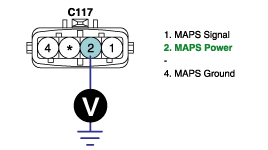
Is the measured voltage within specification ?

▶ Go to "Signal Circuit Inspection" of MAPS.

▶ After repairing open or short to ground in circuits and go to "Verification of Vehicle Repair"
Check short to ground in harness.
IG "OFF"
Disconnect MAPS and PCM connector.
Measure the resistance between terminal 1 of MAPS harness connector and ground.
Specification : Infinite
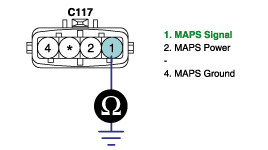
Is the measured resistance within the specification?

▶ Go to "Check open in the harness" procedure.

▶ After repairing short to ground in harness and go to "Verification of Vehicle Repair"
Check open in the harness
IG "OFF"
Disconnect MAPS and PCM connector.
Measure the resistance between terminal 1 of MAPS harness connector and terminal 8 of PCM harness connector
Specification : Approx. below 1 Ω
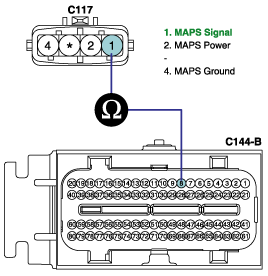
Is the measured resistance within the specification?

▶ Go to "Component Inspection" procedure.

▶ Repair open in the harness and go to "Verification of Vehicle Repair".
MAPS performance test
IG "OFF"
Connect scantool to Data Link Connector(DLC) and selest "Oscilloscope" then, connect probes to output signal lines of MAPS and TPS.Turn engine "ON" and monitor the waveforms accelerating or decelerating
ENG "ON" and monitor signal waveform during accelleration and decelleration.
Pressure (kPa) | 20 | 35 | 60 | 95 | 101.32 | ||
Voltage (V) | 0.789 | 1.382 | 2.369 | 3.75 | 4 | ||
Tolerance (V) | ± 0.045 | ||||||
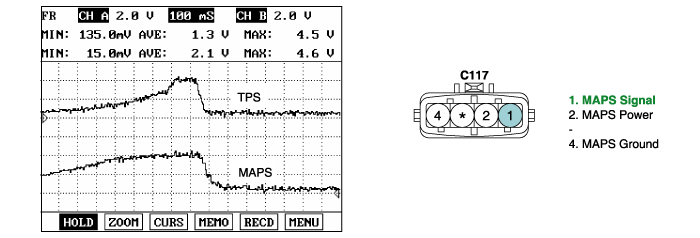
Is the waveform displayed correctly?(Compare the response time of TPS and MAPS)

▶ Go to "Check PCM".

▶ After replacing MAPS with new one, if it operates normally, replace MAPS and go to "Verification of Vehicle Repair".
Check PCM
IG "OFF" disconnect MAPS connector
Connect Scantool and IG "ON" & ENG "OFF"
Select simulation function on scantool.
Simulate voltage at terminal 1 of MAPS harness connector.

Does the output voltage response to the change of signal by simulation?

▶ Thoroughly check connectors for looseness, poor connection, bending, corrosion, contamination, deterioration, or damage. Repair or replace if necessary and go to "Verification of Vehicle Repair" procedure

▶ Substitute with a known - good PCM and check for proper operation. If the problem is corrected, replace PCM and go to "Verification of Vehicle Repair" procedure.
There is a memory reset function on scantool that can erase optional parts automatically detected and memorized by PCM.Before or after testing PCM on the vehicle, use this function to reuse the PCM on the others
After a repair, it is essential to verify that the fault has been corrected.
Monitor and record the Freeze Frame Data for the Diagnostic Trouble Code(DTC) which has been diagnosed.
Using a Scantool, Clear the DTCs
Operate the vehicle within conditions noted in the freeze frame data or enable conditions
Monitor that all rediness test have been verified as " Complete "
Are any DTCs present ?

▶ Go to the applicable troubleshoooting procedure.

▶ System is performing to specification at this time.